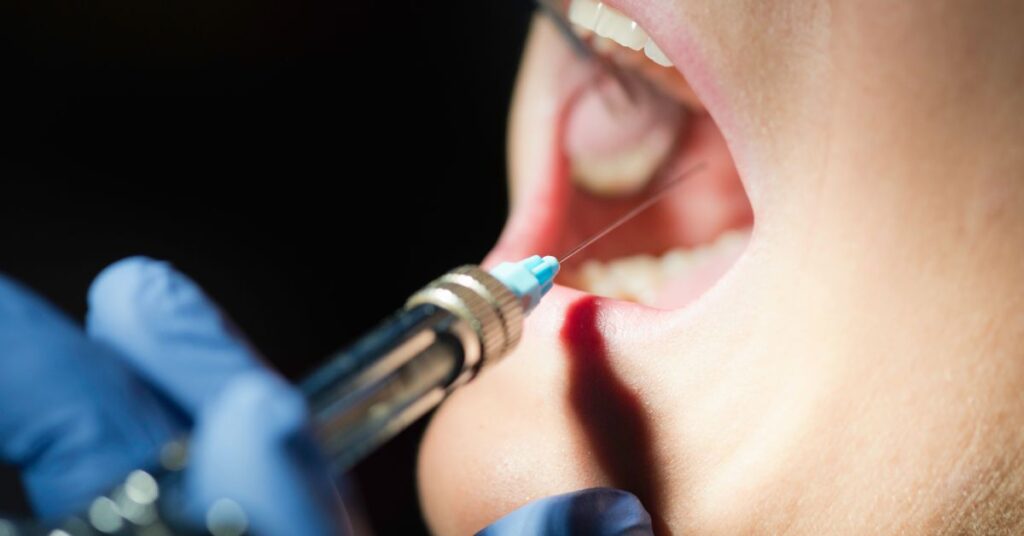
Introduction
Dental anxiety and fear of pain can be significant barriers to obtaining needed oral care. Fortunately, a wide range of anesthesia options are available to control discomfort and make even extensive treatments tolerable. Dental anesthesia refers broadly to the use of agents that induce the loss of sensation or consciousness to perform invasive dental procedures without causing pain.
Local Anesthesia

The use of local anesthetic agents such as lidocaine, articaine, and bupivacaine is extremely common in restorative dentistry. Local anesthetics work by temporarily blocking nerve conduction, which numbs the area of injection and prevents pain signals from reaching the brain. This allows dentists to work comfortably in the numbed area of the mouth without causing discomfort. The mechanism of action involves these agents binding to sodium channels and inhibiting the flow of ions that generate an action potential in nerve fibers. The onset of profound numbness occurs within 2-5 minutes after administration. The clinical applications of local anesthetics are far-reaching – they allow cavity preparations and fillings, tooth extractions, periodontal procedures like scaling and root planing, the placement of dental implants, and countless other treatments to be performed with minimal or no pain during the procedure. Some limitations do exist, however, as extremely anxious patients still require additional relaxant techniques, and some medical conditions like heart block may preclude the use of certain local anesthetics like lidocaine. Still, local anesthesia comprises the backbone of pain control in dentistry.
Sedation Dentistry

While local anesthesia provides numbness and pain control during dental procedures, the sensations of pressure and anxiety may still cause discomfort for some patients. This led to the advent of sedation dentistry techniques that can be used in conjunction with local anesthesia to produce a deeper state of relaxation. The main types of sedation dentistry include nitrous oxide, oral sedative agents, and intravenous sedation. Nitrous oxide is a gas with anxiety-relieving and pain-dampening qualities that is inhaled through a nasal hood. Oral sedatives like Halcion (triazolam) and Valium (diazepam) are anti-anxiety pills taken before appointments to induce relaxation. sedation involves the injection of agents like midazolam and fentanyl to produce moderate to deep sedation during lengthier procedures. With all sedative techniques, patients are still awake but extremely relaxed and unaware of their surroundings. Sedation dentistry has numerous benefits beyond pain control, including increased tolerance for long appointments, amnesia regarding the procedure, and the overall comfort of patients with high dental anxiety needing more extensive care. Careful administration by trained dental professionals ensures safe and consistent sedation with quick recovery afterward.
General Anesthesia

For complex oral surgeries that require absolute motion and unconsciousness, general anesthesia is indicated. Administered by anesthesia providers in hospital settings or specialized dental offices, general anesthesia induces a controlled coma using injectable agents like propofol along with inhaled gases. It causes unconsciousness even with painful stimulation – thereby facilitating trauma surgeries, complex extractions of impacted teeth, and major maxillofacial reconstructions necessitating absolute stillness and lack of pain perception. It differs drastically from lighter levels of sedation that preserve consciousness. There are more medical risks given the depressed vital functions under general anesthesia, but emergency airway equipment and continuous monitoring ensure the protection of patients. It has transformed oral surgery capabilities and enabled office-based surgical care for patients unable to tolerate procedures under local anesthesia or lighter sedation alone.
Conclusion
Dental anxiety need not be a barrier to obtaining excellent oral health with today’s anesthesia capabilities. Local anesthetics allow comfortable routine dental care, while sedation dentistry and general anesthesia facilitate everything ranging from wisdom tooth removal to full mouth rehabilitation for those desiring more advanced relaxation or medically requiring unconsciousness. Patients should discuss their anesthesia preferences with dental providers at their initial consultation. Open dialogue allows customization of the anesthesia regimen to suit individual procedure needs, anxiety levels, medical histories, and willingness for different states of sedation. With patient education and sound clinical judgment, dental anesthesia can ensure that fear does not override dental health but enables access to care.
